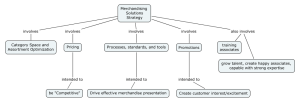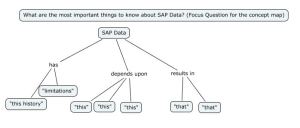My friend Ken is in a strategic initiative leadership role at a large energy company. He found himself in an uncomfortable position, which involved decisions about creating and managing SAP data. His manager responded to Ken with the instruction to “dig in and learn it” and move the initiative towards its milestones. The decisions were technical and had high impact. Not surprisingly, Ken felt stress. Ken resolved the stress by recruiting a technical lead who was more expert with the challenges and qualified to make the decisions.
This incident is a sample of a larger problem. What can a person do when he needs to quickly grasp essential knowledge and there is little opportunity to delegate the decision to an expert? This article provides you a technique for improving the effectiveness of your learning of specialist knowledge.
Mastery of Topics versus “Good Enough”
Textbook learning starts with chapters on the fundamentals. For example, medical training typically considers human anatomy as a fundamental. Then progressively more sophisticated stuff that is layered on top of the fundamentals. The learner’s job is to structure and retain this knowledge. If the stakes are high – again, think about medicine – we expect mastery as the standard.
Real-world learning is usually some sort of problem solving using “muddling through” as a strategy. That means that the learner grabs some bits and pieces of knowledge and applies it to see what works. Sometimes, they will observe others solving the same or related problems.
This real-world muddling approach is typical: there isn’t time to “go back to school.” Specialists understand the specifics, and can work with the jargon and deeper layers of meaning. Management generalists like Ken delegate and defer where they can. But when it comes to integration of the components, they are left to make the best decisions that they can and hope for the best.
Might there be a way to apply real-world learning styles in a way that allows for individual mastery and improved communications?
Faster Learning, Real-World Style
 I discovered a solution that finds a middle ground between formalized textbook-style learning and muddling through. This approach, works by asking focus questions and constructing propositions. The result is a hierarchical concept map that renders a scaffold of relevant knowledge. Please review the nearby graphic, and you will get a sense of that statement. (I explained the story behind this graphic in this earlier article.)
I discovered a solution that finds a middle ground between formalized textbook-style learning and muddling through. This approach, works by asking focus questions and constructing propositions. The result is a hierarchical concept map that renders a scaffold of relevant knowledge. Please review the nearby graphic, and you will get a sense of that statement. (I explained the story behind this graphic in this earlier article.)
To relate to Ken’s example, the first step for Ken might be to ask himself this question: “What do I already know about SAP data?” His answers might be: I know “this” and “this” and “this,” jotting the specifics on paper or perhaps on sticky notes. The nearby graphic shows what that concept map would look like.
 Concept maps are extraordinarily valuable because they include the linking words, in this case the linking word is “includes.” The linkages show a relationship between concepts that we call propositions.
Concept maps are extraordinarily valuable because they include the linking words, in this case the linking word is “includes.” The linkages show a relationship between concepts that we call propositions.
 As a next step, Ken could go to people more knowledgeable than he (there are thousands of SAP experts available, and Ken’s project employed several dozen SAP consultants) and ask a question such as, “What are the most important things to know about SAP data, in the context of our strategic initiative?” As he organizes what he learns (more instances of “this” and “this), he continues to elaborate what he knows. It is an organized knowledge structure, perhaps more accurately called a knowledge scaffold.
As a next step, Ken could go to people more knowledgeable than he (there are thousands of SAP experts available, and Ken’s project employed several dozen SAP consultants) and ask a question such as, “What are the most important things to know about SAP data, in the context of our strategic initiative?” As he organizes what he learns (more instances of “this” and “this), he continues to elaborate what he knows. It is an organized knowledge structure, perhaps more accurately called a knowledge scaffold.
Focus Questions
In the prior example, I used two different focus questions to generate the concept maps. Note this essential point,
The purpose of a concept map is to help answer a focus question.
The relationship between the two is what makes this a powerful technique for learning, and thus a useful strategic tool.
As I practiced my first concept maps, I found that I would often just muddle for a while and then realize I was wasting time. Then I would try to find a focus question that organized my muddled set of propositions.
Researchers validate my experience. Canas and Novak, in a review of the technique, reaffirm that it is a powerful learning tool. But they note that, “some difficulties seem to be pervasive.” The two most-relevant difficulties (for practitioners like me and you) are:
- Developing skill in constructing and structuring propositions
- Developing skill in asking good focus questions that relate to the concept map
I recommend that you follow the model suggested for Ken. The first focus question to ask is, “What do I already know about this topic?” Construct your propositions with the word “includes.”
Develop a second concept map by asking the experts this question to generate a deeper level of understanding, “What is essential to know about this topic?” Here is an enlightening twist, “What are the seven most-important things to know about this topic?” By limiting the number of propositions at the high level, you learn which things are truly essential. Then deepen the concept map to understand those concepts that are most important to the high-level essentials.
Conclusion
Ken’s situation is common in strategic initiatives. It is related to two similar strategic initiative challenges:
- How much subject matter knowledge should you personally attempt to grasp? As a leader, understanding the technical challenges at a level that assures that the program is making quality decisions.
- How can you facilitate sharing of expert knowledge to others? Application of expertise and proprietary knowledge is at the heart of any strategy. Communications is an essential leadership task. The challenge is to conveying appropriate technical information quickly and effectively.
I heartily endorse concept maps as a useful tool and hope you will practice and build skill. They are deceptively simple when you see a good one that has been developed by someone else. I encourage you to persist.
Have you used concept maps and focus questions? What were the results?

Greg: looks like a nice tool; sort of a hierarchical mind mapping or affinity diagram with a little bit of ERD thrown in for good measure.
Thanks John
I didn’t mention it in the blog, but free software available at http://www.ihmc.us I’m a big advocate. Yes you are right that it is a hierarchical mind map, which IMO makes it a superior approach. What is ERD?